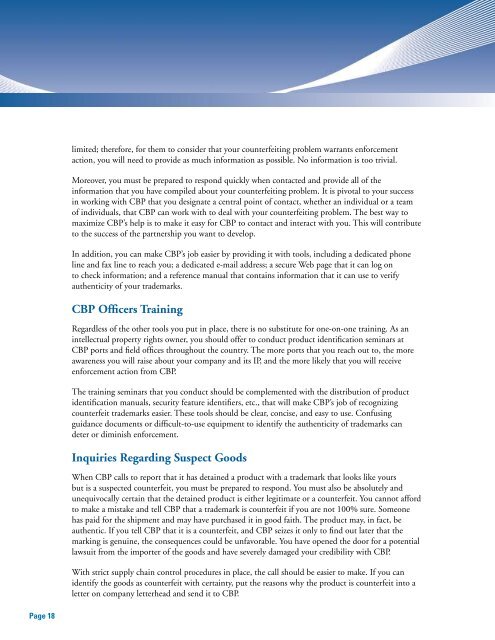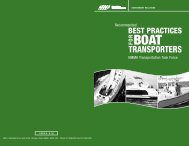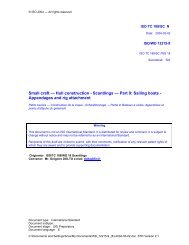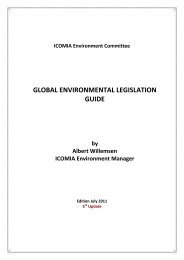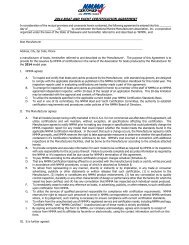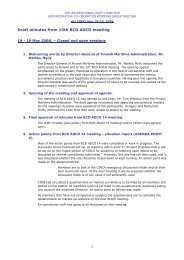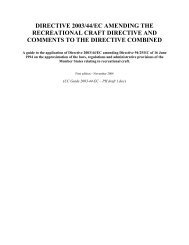Intellectual Property Protection and Enforcement Manual - Ipr-policy.eu
Intellectual Property Protection and Enforcement Manual - Ipr-policy.eu
Intellectual Property Protection and Enforcement Manual - Ipr-policy.eu
You also want an ePaper? Increase the reach of your titles
YUMPU automatically turns print PDFs into web optimized ePapers that Google loves.
limited; therefore, for them to consider that your counterfeiting problem warrants enforcement<br />
action, you will need to provide as much information as possible. No information is too trivial.<br />
Moreover, you must be prepared to respond quickly when contacted <strong>and</strong> provide all of the<br />
information that you have compiled about your counterfeiting problem. It is pivotal to your success<br />
in working with CBP that you designate a central point of contact, whether an individual or a team<br />
of individuals, that CBP can work with to deal with your counterfeiting problem. The best way to<br />
maximize CBP’s help is to make it easy for CBP to contact <strong>and</strong> interact with you. This will contribute<br />
to the success of the partnership you want to develop.<br />
In addition, you can make CBP’s job easier by providing it with tools, including a dedicated phone<br />
line <strong>and</strong> fax line to reach you; a dedicated e-mail address; a secure Web page that it can log on<br />
to check information; <strong>and</strong> a reference manual that contains information that it can use to verify<br />
authenticity of your trademarks.<br />
CBP Officers Training<br />
Regardless of the other tools you put in place, there is no substitute for one-on-one training. As an<br />
intellectual property rights owner, you should offer to conduct product identification seminars at<br />
CBP ports <strong>and</strong> field offices throughout the country. The more ports that you reach out to, the more<br />
awareness you will raise about your company <strong>and</strong> its IP, <strong>and</strong> the more likely that you will receive<br />
enforcement action from CBP.<br />
The training seminars that you conduct should be complemented with the distribution of product<br />
identification manuals, security feature identifiers, etc., that will make CBP’s job of recognizing<br />
counterfeit trademarks easier. These tools should be clear, concise, <strong>and</strong> easy to use. Confusing<br />
guidance documents or difficult-to-use equipment to identify the authenticity of trademarks can<br />
deter or diminish enforcement.<br />
Inquiries Regarding Suspect Goods<br />
When CBP calls to report that it has detained a product with a trademark that looks like yours<br />
but is a suspected counterfeit, you must be prepared to respond. You must also be absolutely <strong>and</strong><br />
unequivocally certain that the detained product is either legitimate or a counterfeit. You cannot afford<br />
to make a mistake <strong>and</strong> tell CBP that a trademark is counterfeit if you are not 100% sure. Someone<br />
has paid for the shipment <strong>and</strong> may have purchased it in good faith. The product may, in fact, be<br />
authentic. If you tell CBP that it is a counterfeit, <strong>and</strong> CBP seizes it only to find out later that the<br />
marking is genuine, the consequences could be unfavorable. You have opened the door for a potential<br />
lawsuit from the importer of the goods <strong>and</strong> have severely damaged your credibility with CBP.<br />
With strict supply chain control procedures in place, the call should be easier to make. If you can<br />
identify the goods as counterfeit with certainty, put the reasons why the product is counterfeit into a<br />
letter on company letterhead <strong>and</strong> send it to CBP.<br />
Page 18


